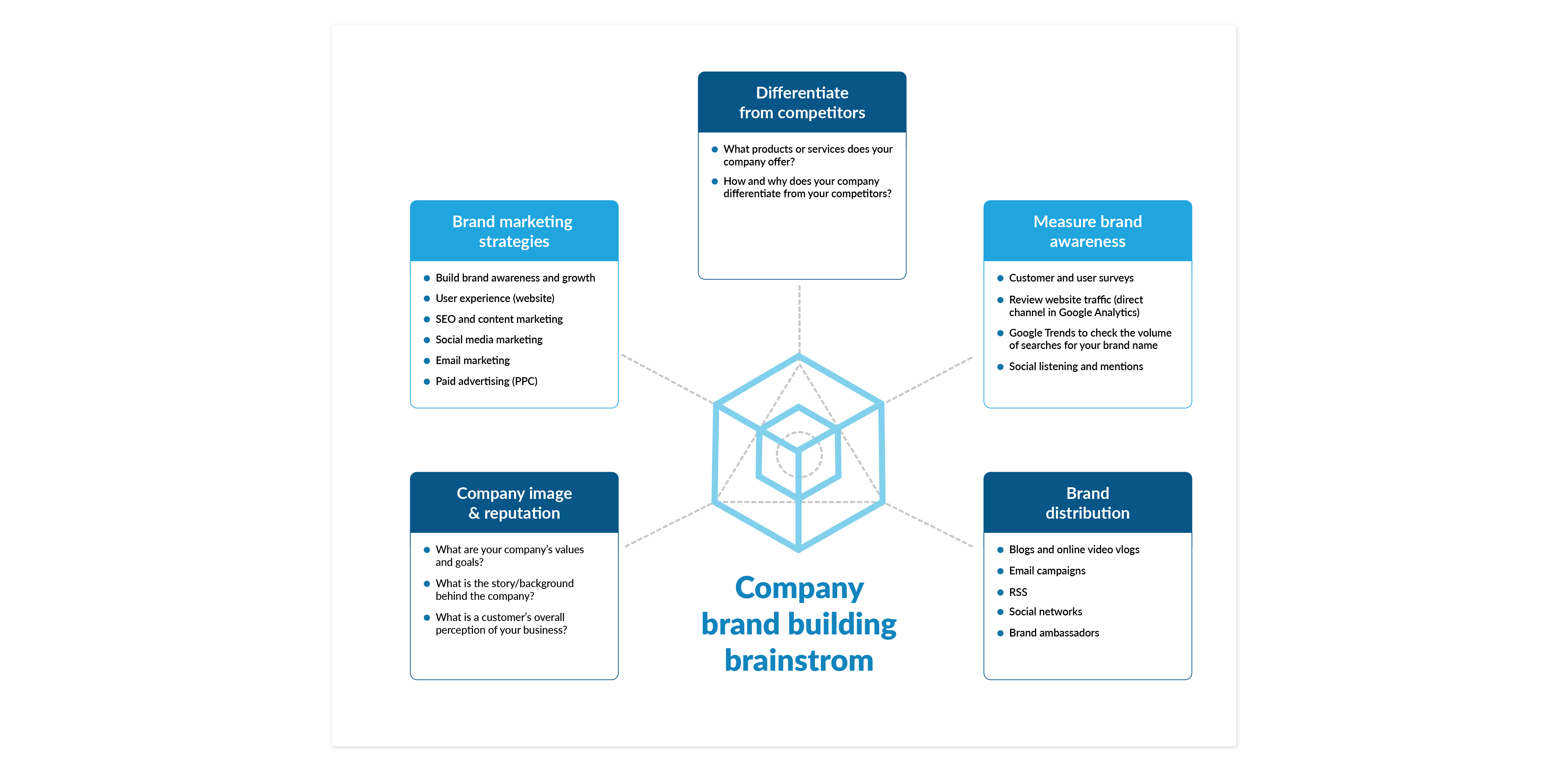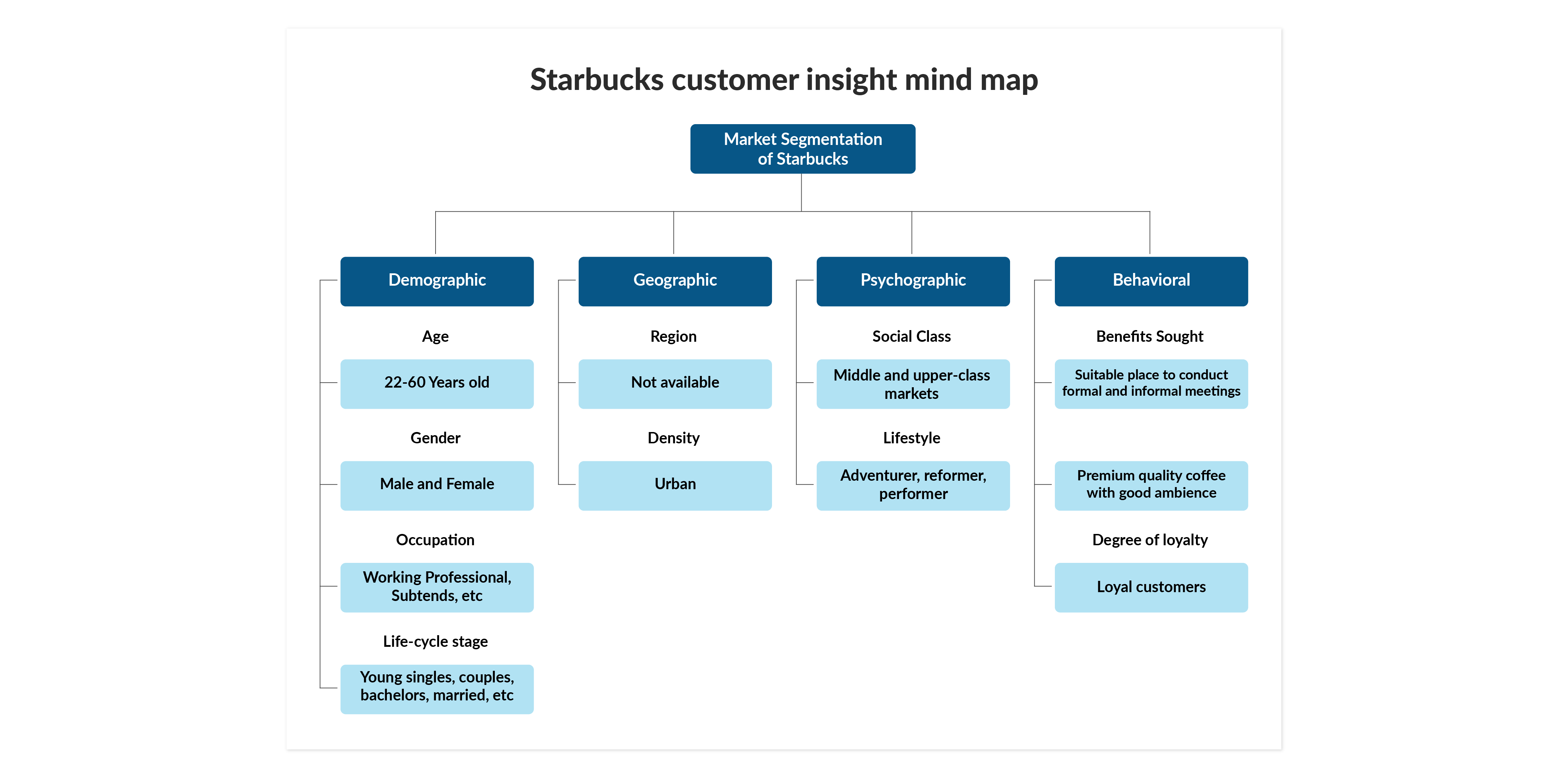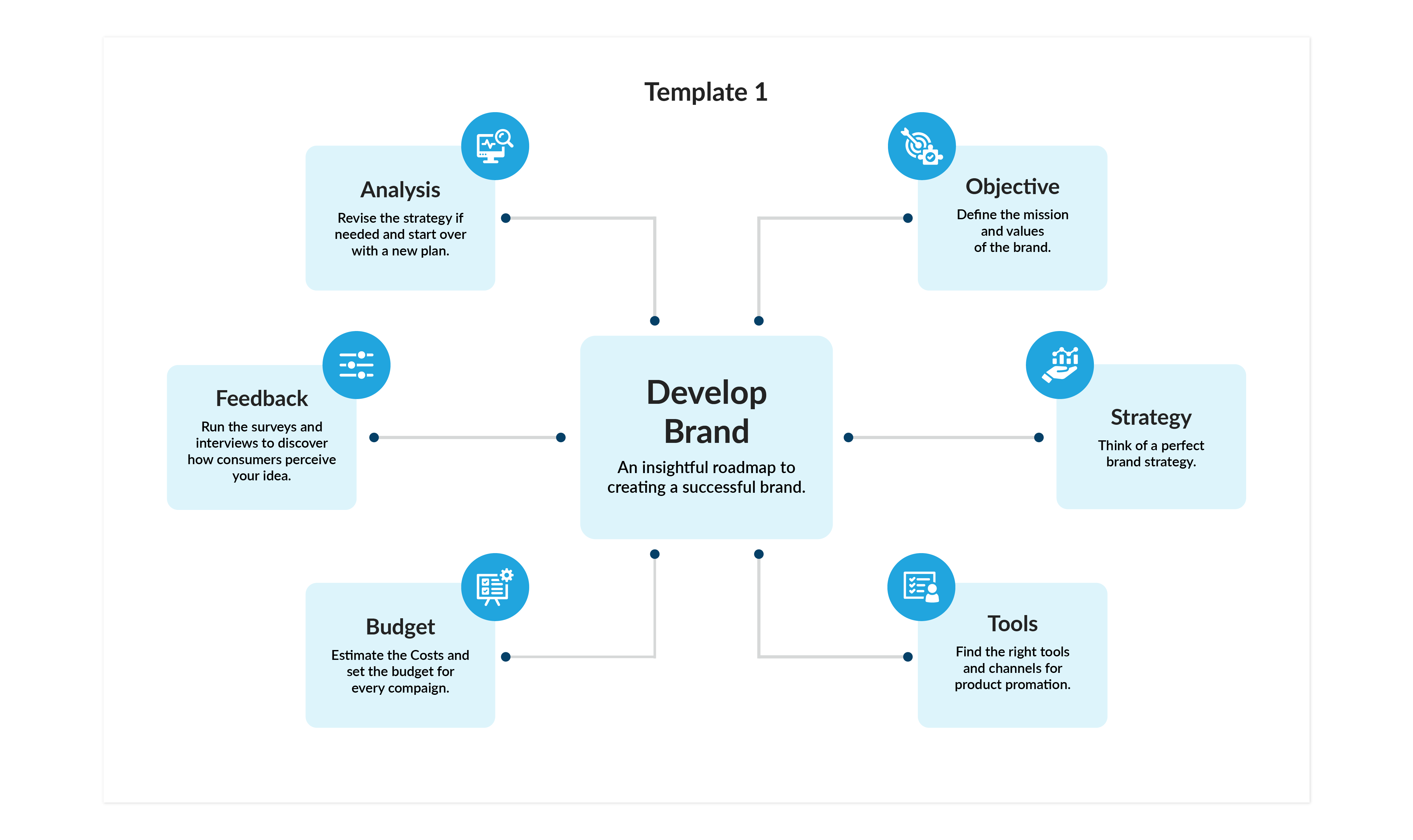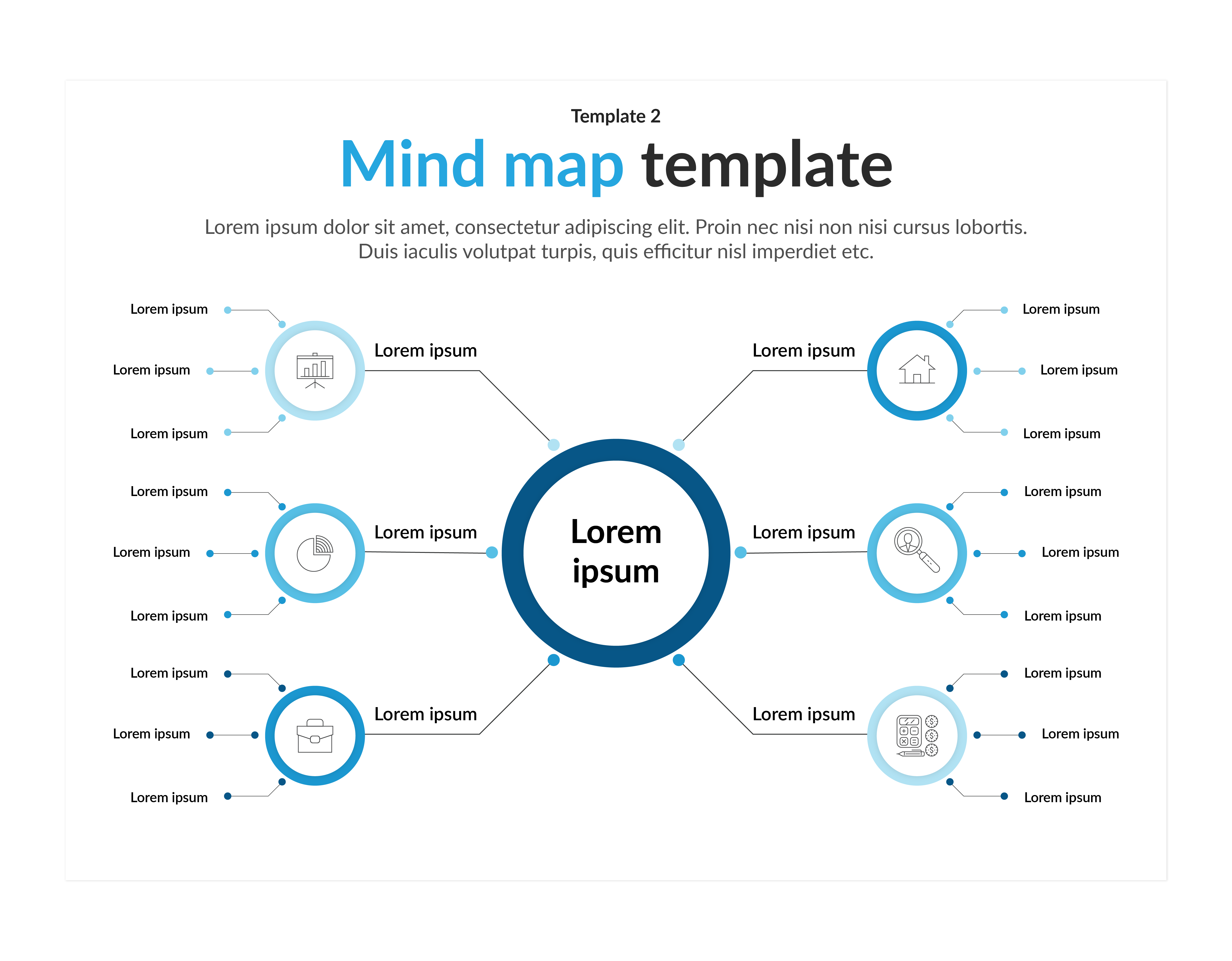How to use mind maps for a winning brand strategy?

Imagine you're setting out to paint a masterpiece, but instead of brushes and paints, your tools are ideas and insights about your brand. At first, the canvas looks vast and daunting—where should the first stroke go? What colors will bring out the essence of the image you want to convey?
This is the challenge many face when developing a brand strategy. It's not just about deciding on a logo or a tagline; it's about crafting a cohesive narrative that resonates with audiences and stands the test of time. Mind map is a visual that serves as the sketchbook for your brand's story, allowing you to explore various angles and connect disparate ideas into a coherent strategy.
By visually organizing thoughts and fostering a free flow of ideas, mind maps help brand strategists see new possibilities, align their team's vision, and meticulously plan the steps needed to captivate the market. From defining your brand’s core message to analyzing competitive landscapes, mind maps simplify the complexity of brand strategy.
In the next sections, we’ll explore how mind maps can transform the nebulous task of branding into a clear, actionable plan.
What is a mind map?
While most professionals are familiar with mind maps as a tool to brainstorm ideas, there's a deeper layer to their effectiveness that can transform the way we approach complex challenges. Mind maps aren't just visual aids; they are a reflection of our cognitive processes, encapsulating the way we connect disparate ideas into coherent strategies.

Renowned psychologist Tony Buzan, who popularized the term "mind map" in the 1970s, described them as a "mirror of your brain's thinking process," noting that they leverage the full range of cortical skills—word, image, number, logic, rhythm, color, and spatial awareness. This makes mind maps uniquely potent for brand strategists, who must weave narrative, data, aesthetics, and strategy into a cohesive plan.
A mind map begins with a central idea—like the core mission of a brand—and extends outward in all directions with branches that represent major and minor strategic elements. This radial structure not only facilitates more intuitive navigation and understanding of the information but also mirrors the way ideas often spring from the mind, reflecting a more natural thinking process.
Mind map for marketing vs mind map for branding
Before diving into how mind maps can enhance brand strategies, it's important to grasp that mind maps for marketing and branding, while seemingly similar, serve distinctly different purposes. Each targets specific aspects of business strategy and requires a tailored approach to be effective.
Mind maps for marketing
Marketing mind maps are operational and tactical. They are utilized primarily to outline and execute marketing campaigns, detailing every step from concept to completion. These mind maps are granular, often including timelines, budget allocations, specific channels, and expected outcomes for each activity.
For example, a marketing mind map may start with a central node titled "Product Launch," branching out to various campaign elements like "Digital Ads," "Email Campaigns," "Social Media," and "Promotional Events." Each branch then delves into specifics such as key messages, target demographics, execution timelines, and metrics for measuring success.
Mind maps for branding
Conversely, branding mind maps focus on the strategic positioning and identity of a brand within the market. They explore core values, the brand's mission, vision, personality, and emotional connections intended to resonate with the target audience.
A branding mind map might center around the brand's essence, with branches extending to "Visual Identity," "Brand Voice," "Customer Persona," "Competitive Landscape," and "Value Proposition." Each segment emphasizes the development of a cohesive brand narrative that aligns with the company’s long-term goals and consumer expectations.
While both types of mind maps aim to streamline and organize complex information, the key difference lies in their end goals: marketing mind maps are designed for direct action and measurable outcomes, whereas branding mind maps prioritize conceptual depth and emotional engagement with potential and existing customers.
Understanding these differences is crucial when developing mind maps for your business, ensuring that each map is purpose-built to support either your marketing tactics or branding strategy effectively.
Why are mind maps effective for a brand strategy?
Mind maps are particularly effective for brand strategy due to their ability to simplify complex ideas and foster creative, comprehensive thinking.
Your brand strategy isn't just about the name, logo, or tagline. It's more about identifying your core brand value. That's the heart ❤️ of your business. It's why you matter in the market - Emily Branch, VP of Brand Marketing, Prezent
Here are several reasons why incorporating mind maps into brand strategy can be beneficial:
Enhances visualization of the brand ecosystem
Mind maps allow brand strategists to visualize their ideas and relationships between various elements of a brand’s ecosystem. This includes how brand values align with customer expectations, the interplay between different marketing channels, and the cohesion of brand messaging across platforms. By seeing these elements visually represented, strategists can identify synergies and discrepancies more easily, ensuring a unified brand narrative.
Encourages holistic thinking
The radial structure of a mind map encourages users to think holistically about brand strategy. Rather than viewing components of a brand's identity, audience, and market environment in isolation, mind maps facilitate a comprehensive overview. This helps in understanding how modifying one aspect of the strategy affects others, promoting a balanced approach to brand development.
Renowned branding expert Martin Lindstrom notes, “Mind maps allow marketers to visualize the brand as a universe, where every touchpoint is interconnected.” This approach is vital when ensuring all elements of a brand’s presence harmonize and support the overall brand promise.

Facilitates brainstorming and collaboration
Mind maps serve as a focal point which teams can collaboratively build upon. Each participant can contribute ideas, which can then be connected or expanded upon directly within the map, fostering a collaborative environment where creativity flourishes.
Google’s innovation labs use brainstorming mind maps for product ideas, branding, and marketing strategies. The collaborative nature of mind maps makes it easier for teams to contribute ideas and see how they fit into the larger strategy, fostering a creative environment.
Streamlines information and improves memorization
The use of colors, images, and a structured layout in mind maps helps in organizing information more efficiently and making it memorable. For brand strategists, this means key elements of the brand’s strategy can be recalled and communicated more effectively, which is crucial when ensuring consistency across all marketing and operational activities.
A study published in the Journal of Educational Psychology suggests that visual aids in learning, like mind maps, can improve memory retention by up to 32%.
Agile adaption to changes
In the fast-evolving business landscape, brand strategies often need to adapt quickly. Mind maps provide a flexible platform where changes can be integrated easily without losing sight of the larger picture. This agility makes it easier to respond to market shifts, competitive pressures, or changes in consumer behavior with minimal disruption.
Efficient communication tool
Finally, mind maps are an excellent way to communicate complex brand strategies to stakeholders at all levels—from team members to external partners and even investors. The clarity and engaging visual format of mind maps make them accessible and quickly understandable, aiding in garnering support and ensuring alignment across the organization.
As Jeff Bezos from Amazon says, “We use mind maps during our annual planning meetings. It helps everyone see the full picture and the parts they are responsible for.”
By leveraging the strengths of mind maps, brand strategists can create dynamic, resilient strategies that are not only aligned with the company's vision but are also adaptable and clearly understood by all stakeholders involved.
Key elements for a branding mind map
Creating an effective branding mind map involves understanding and visualizing the core components that define and drive a brand's identity. Here are some key elements to make your mind map, each serving a specific purpose in the larger context of brand strategy development:
Core values and mission:
This is the foundation or central idea of your brand, defining its purpose and guiding its trajectory. The core values encapsulate what the brand stands for, influencing all other aspects of business operations and marketing strategy. The mission statement provides a clear focus, offering a compass for all strategic decisions and helping align the team's efforts.
Target audience:
Detailed knowledge of who your customers are is vital. This includes demographic data such as age, location, and income level, as well as psychographic information like interests, lifestyles, and values. Understanding your audience deeply allows you to tailor messages that resonate on a personal level and meet the audience's specific needs and preferences.
Competitor analysis:
Analyzing your competitors helps you understand your market position and identify opportunities for differentiation. This involves looking at your competitors’ strengths and weaknesses and understanding their strategies. By knowing where you stand relative to others in your industry, you can better highlight your brand's unique attributes and find niches that are underserved.
Marketing strategies:
This section should map out how you plan to reach and engage with your target audience. It includes choosing the right channels, such as social media, email marketing, SEO, and traditional advertising, and deciding on the content and campaigns that will be most effective. Each marketing effort should align with the overall brand strategy and work towards achieving specific objectives set by the brand.
Customer journey:
Charting the customer journey involves mapping out every interaction customers have with your brand, from initial awareness through to purchase and post-purchase activities. This journey provides insights into the customer's experience and helps identify key touchpoints where the brand can engage effectively to enhance customer satisfaction and loyalty.
Brand voice and personality:
This defines the consistent tone and personality of your brand communications across all platforms. Whether your brand voice is professional, friendly, authoritative, or playful, it should reflect your core values and resonate with your target audience. Consistency in your brand voice helps build a strong, recognizable brand identity.
Visual identity:
This includes the visual elements that represent your brand, such as logos, color schemes, typography, and imagery. A strong visual identity makes your brand easily recognizable and enhances brand recall. It's crucial that these elements are used consistently across all marketing materials to maintain brand integrity.
Value proposition:
Your value proposition communicates the principal reasons why your product or service is better than the competition. It not only highlights the benefits and features of your products but also explains how they address the needs or solve the problems of your target audience. A compelling value proposition can be a decisive factor in winning over customers.
By ensuring that each of these elements is carefully considered and well-integrated into your branding mind map, you can create a comprehensive strategy that effectively communicates your brand’s story, engages your audience, and distinguishes your brand in the marketplace.
Comprehensive guide to creating an innovative mind map for brand strategy
Creating a mind map for brand strategy can be a dynamic and innovative process if approached with creativity and strategic foresight. Here’s a step-by-step guide to ensure each component of your mind map is valuable and well-explained:
1. Choose a mind mapping tool
- Purpose: Select a digital tool that supports creative freedom and customization. Options like MindMeister, XMindr, or Prezent are popular mind map makers.
- Detail: Look for features like easy drag-and-drop interfaces, extensive template libraries, and options for adding media or links. These features help in creating a more interactive and detailed mind map.
2. Central node: "Brand strategy"
- Purpose: Establish the core focus of your mind map. This central node will anchor all other elements of your strategy.
- Detail: Label this node clearly as “Brand Strategy” to emphasize the comprehensive nature of the map’s content plan. This helps maintain focus as you branch out into specific areas.
3. Main branches: Key components
- Purpose: Create branches for each critical aspect of your brand strategy: Brand Vision, Target Audience, Brand Positioning, Brand Identity, Marketing Strategy, Customer Experience, and Performance Metrics.
- Detail: Arrange these branches in a logical flow around the central node, ensuring each is clearly labeled and positioned for easy navigation.
4. Sub-branches: Detailed elements
- Purpose: Under each main branch, add sub-branches that detail the specific elements and initiatives relevant to that aspect of the brand strategy. This enhances the granularity and utility of the mind map, making it a practical tool for both strategic planning and execution.
- Detail: For instance, under "Marketing Strategy", you might have subtopics like "Digital Advertising", "Social Media", and "Public Relations". Use different colors or shapes for sub-branches to visually distinguish them, aiding in quicker comprehension and review.
5. Customization: Enhance visual appeal
- Purpose: Customize the visual aspects of your mind map to make it more intuitive and visually appealing. This helps in engaging the viewer and can make complex information easier to digest.
- Detail: Choose a color scheme that reflects your brand’s identity, use fonts that are easy to read, and apply varying styles to differentiate between levels of hierarchy within the map.
6. Icons and images: Visual enhancements
- Purpose: Add icons or images next to each section of your mind map. This can make the map more engaging and help users quickly associate visual elements with the content.
- Detail: For example, use an icon of a person to represent the "Target Audience" branch or a bullseye icon for "Brand Positioning". These visual cues can enhance understanding and retention of information.
7. Final touches: Layout and readability
- Purpose: Adjust the layout of your mind map to ensure that it is easy to read and aesthetically balanced. Good organization can significantly impact the usability and effectiveness of your mind map.
- Detail: Make sure there’s ample space between branches to prevent clutter. Ensure that all text is legible, with larger fonts for main branches and slightly smaller fonts for sub-branches. If necessary, rearrange elements to maintain a balanced look and feel.

Case studies and mind map templates
Starbucks: Enhancing brand identity through customer insights
Starbucks has effectively used mind maps to refine its brand strategy by integrating customer insights directly into its brand development processes. By creating a mind map that visualized customer preferences and values, Starbucks identified opportunities for enhancing its brand experience. This led to the development of their mobile app, which personalized customer interactions and reinforced the brand's image as innovative and customer-focused.

Nike: Aligning brand values with marketing initiatives
Nike employs mind maps to ensure that its marketing campaigns reflect its core brand values of inspiration and innovation. By visually mapping out the connections between campaign goals and brand messaging, Nike ensures consistency across all marketing channels. This approach was pivotal in the success of the "JUST DO IT" campaign, which not only boosted sales but also solidified Nike’s reputation as a brand that supports and empowers athletes regardless of gender.

Popular mind map design templates to inspire you




How Prezent enhances mind mapping and brand building
Prezent. offers a suite of features that can significantly streamline the process of mind mapping and brand strategy development. These tools are designed to maintain brand consistency while enhancing communication and strategic planning. Have a look
Slide library
Access to over 35,000 pre-designed slides that conform to your company’s brand guidelines simplifies the process of creating mind maps. Users can quickly select and customize slides that are already aligned with their brand's visual identity, ensuring that every mind map not only serves its strategic purpose but also upholds the brand's aesthetic standards. This is particularly useful when presenting brand strategies to stakeholders, ensuring consistency and professionalism.
Auto generator
The Auto Generator feature uses prompts to create hyper-personalized, on-brand decks in minutes. This tool can accelerate the creation of mind maps by auto-populating slides with relevant content based on user input. It allows strategists to focus more on the creative and analytical aspects of brand strategy rather than on slide creation, enhancing productivity and strategic focus.
Best practice library
With access to thousands of best practice examples for communicating key business concepts, strategists can draw upon a rich resource of proven strategies and visual layouts. This library is invaluable for ensuring that mind maps are not only visually compelling but also effective in communicating complex brand strategies in an understandable and engaging way.
Template converter
The ability to convert existing slides into any of your brand templates while staying 100% brand compliant is crucial for maintaining consistency across all corporate communications. This feature ensures that all strategic documents and presentations are aligned with the brand’s visual guidelines, which is essential for cohesive brand identity.
Courses
The availability of bite-sized, gamified learning modules on business communication allows team members to enhance their skills in creating effective presentations and strategic documents. This educational component ensures that all team members can contribute effectively to the mind mapping process, equipped with the latest best practices in business communication and strategic planning.
Utilizing Prezent's comprehensive toolkit, companies can enhance their mind mapping processes, making them more efficient, visually consistent, and strategically aligned with broader business goals. You can book a demo to learn more about these features or sign up for a 14-days free trial!



.avif)








